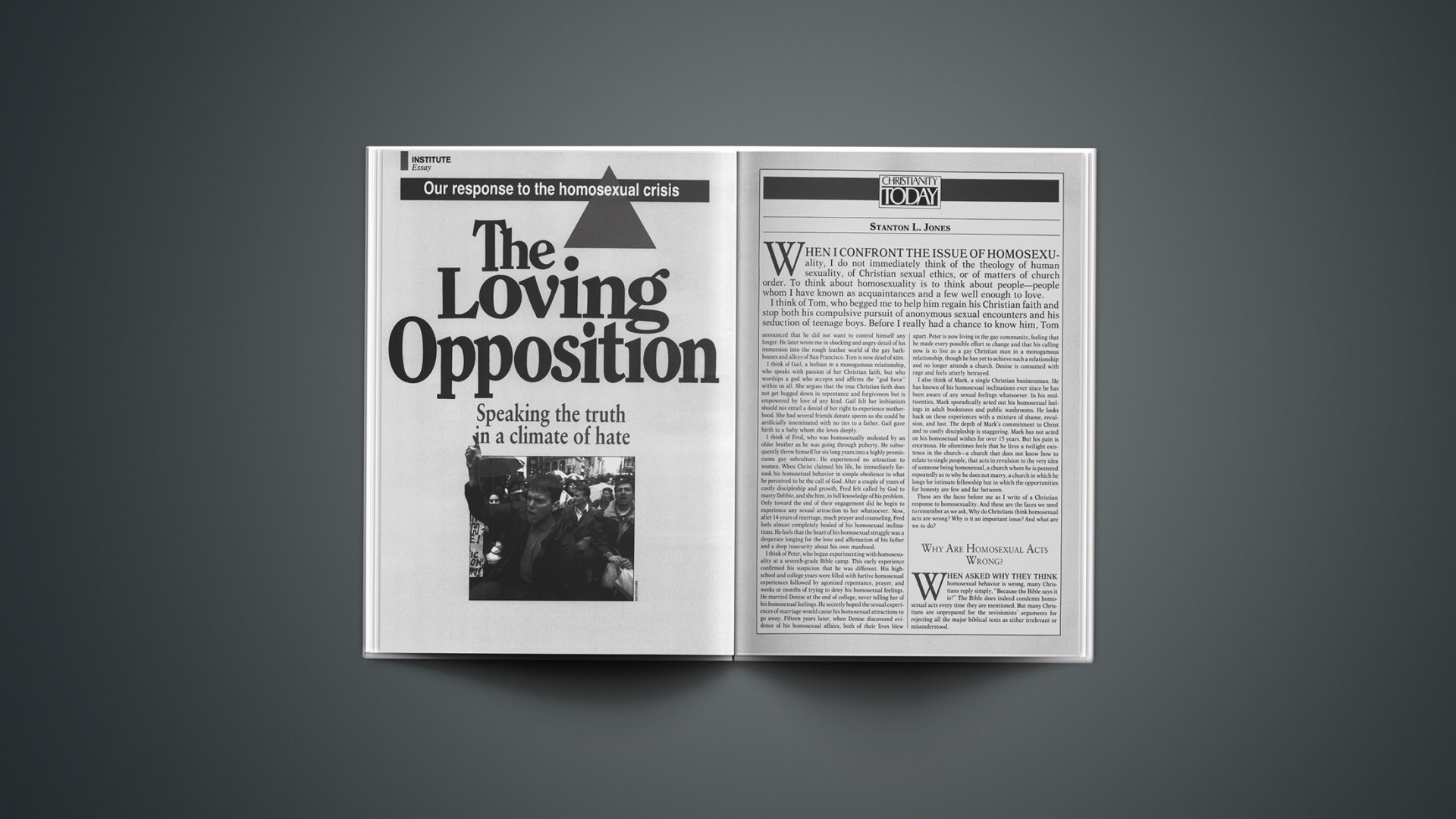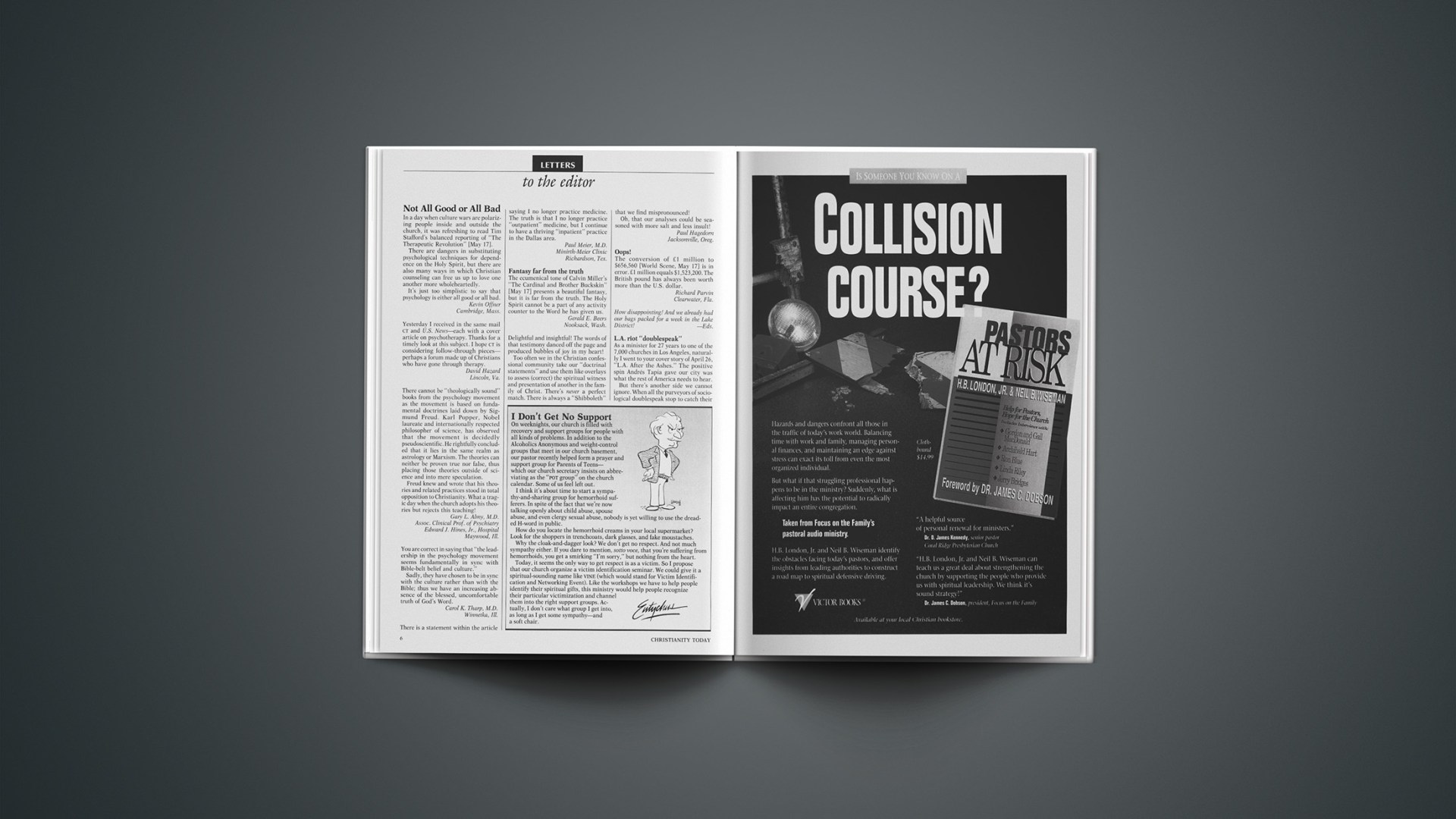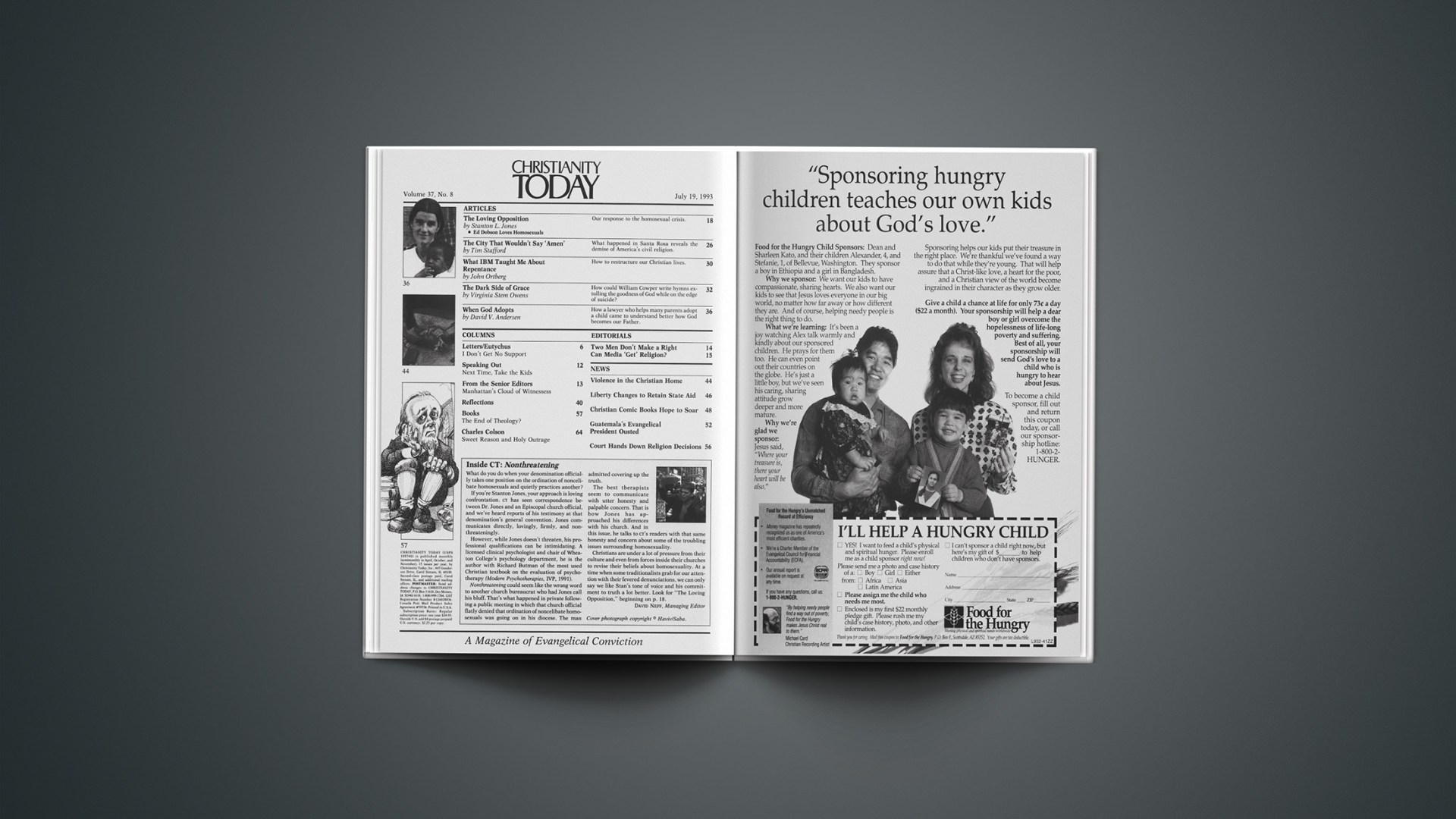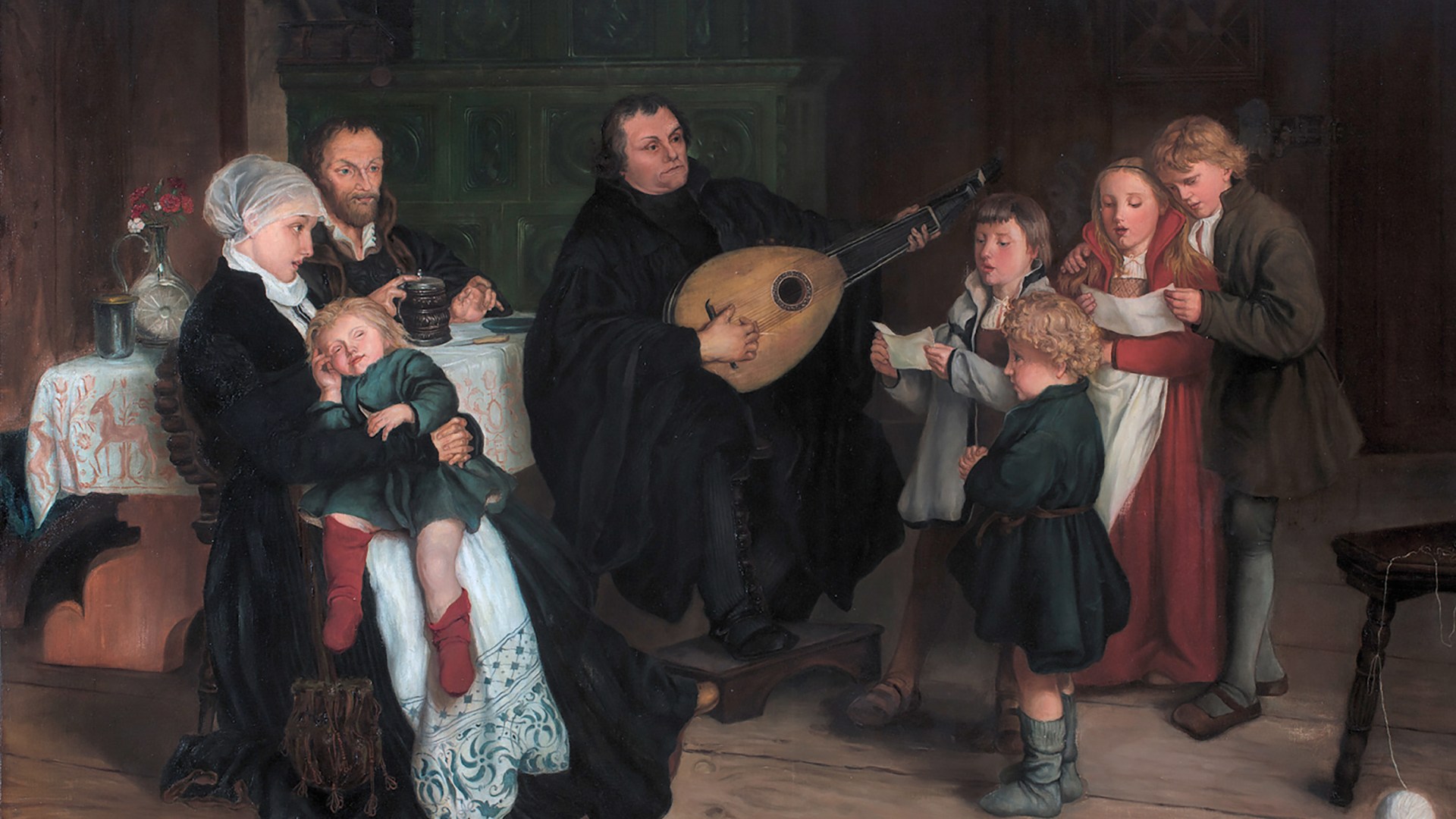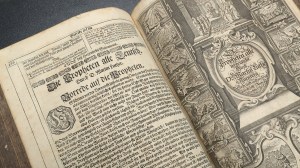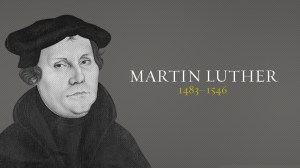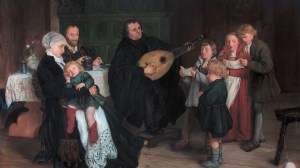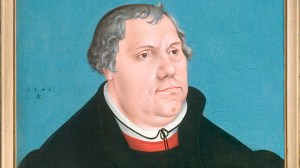When i confront the issue of homosexuality, I do not immediately think of the theology of human sexuality, of Christian sexual ethics, or of matters of church order. To think about homosexuality is to think about people—people whom I have known as acquaintances and a few well enough to love.
I think of Tom, who begged me to help him regain his Christian faith and stop both his compulsive pursuit of anonymous sexual encounters and his seduction of teenage boys. Before I really had a chance to know him, Tom announced that he did not want to control himself any longer. He later wrote me in shocking and angry detail of his immersion into the rough leather world of the gay bathhouses and alleys of San Francisco. Tom is now dead of AIDS.
I think of Gail, a lesbian in a monogamous relationship, who speaks with passion of her Christian faith, but who worships a god who accepts and affirms the “god force” within us all. She argues that the true Christian faith does not get bogged down in repentance and forgiveness but is empowered by love of any kind. Gail felt her lesbianism should not entail a denial of her right to experience motherhood. She had several friends donate sperm so she could be artificially inseminated with no ties to a father. Gail gave birth to a baby whom she loves deeply.
I think of Fred, who was homosexually molested by an older brother as he was going through puberty. He subsequently threw himself for six long years into a highly promiscuous gay subculture. He experienced no attraction to women. When Christ claimed his life, he immediately forsook his homosexual behavior in simple obedience to what he perceived to be the call of God. After a couple of years of costly discipleship and growth, Fred felt called by God to marry Debbie, and she him, in full knowledge of his problem. Only toward the end of their engagement did he begin to experience any sexual attraction to her whatsoever. Now, after 14 years of marriage, much prayer and counseling, Fred feels almost completely healed of his homosexual inclinations. He feels that the heart of his homosexual struggle was a desperate longing for the love and affirmation of his father and a deep insecurity about his own manhood.
I think of Peter, who began experimenting with homosexuality at a seventh-grade Bible camp. This early experience confirmed his suspicion that he was different. His high-school and college years were filled with furtive homosexual experiences followed by agonized repentance, prayer, and weeks or months of trying to deny his homosexual feelings. He married Denise at the end of college, never telling her of his homosexual feelings. He secretly hoped the sexual experiences of marriage would cause his homosexual attractions to go away. Fifteen years later, when Denise discovered evidence of his homosexual affairs, both of their lives blew apart. Peter is now living in the gay community, feeling that he made every possible effort to change and that his calling now is to live as a gay Christian man in a monogamous relationship, though he has yet to achieve such a relationship and no longer attends a church. Denise is consumed with rage and feels utterly betrayed.
I also think of Mark, a single Christian businessman. He has known of his homosexual inclinations ever since he has been aware of any sexual feelings whatsoever. In his mid-twenties, Mark sporadically acted out his homosexual feelings in adult bookstores and public washrooms. He looks back on these experiences with a mixture of shame, revulsion, and lust. The depth of Mark’s commitment to Christ and to costly discipleship is staggering. Mark has not acted on his homosexual wishes for over 15 years. But his pain is enormous. He oftentimes feels that he lives a twilight existence in the church—a church that does not know how to relate to single people, that acts in revulsion to the very idea of someone being homosexual, a church where he is pestered repeatedly as to why he does not marry, a church in which he longs for intimate fellowship but in which the opportunities for honesty are few and far between.
These are the faces before me as I write of a Christian response to homosexuality. And these are the faces we need to remember as we ask, Why do Christians think homosexual acts are wrong? Why is it an important issue? And what are we to do?
WHY ARE HOMOSEXUAL ACTS WRONG?
When asked why they think homosexual behavior is wrong, many Christians reply simply, “Because the Bible says it is!” The Bible does indeed condemn homosexual acts every time they are mentioned. But many Christians are unprepared for the revisionists’ arguments for rejecting all the major biblical texts as either irrelevant or misunderstood.
This is a thumbnail sketch of what one will hear from critics of the traditional view:
They argue that Leviticus 18:22; 20:13, and Deuteronomy 23:18, which condemn male homosexual behavior, are irrelevant because they do not address today’s homosexual lifestyles, These passages occur in the midst of a discussion of God’s disapproval of the fertility cults in the pagan communities surrounding the Israelites. The only kind of homosexual behavior the Israelites knew, it is argued, was homosexual prostitution in pagan temples. That is what is being rejected here and not the loving monogamous gay relationship of persons of homosexual orientation today.
The Genesis 19 story of Sodom and Gomorrah is alleged to be irrelevant because it is a story of attempted gang rape, which was an indicator of the general wickedness of the city. The homosexual nature of the gang rape is seen as an irrelevant detail of the story.
Romans 1 is often reduced to being a condemnation solely of heterosexual people who engage in homosexual acts. They rebel against God by engaging in what is unnatural to them. This passage has no relevance today, it is argued, because modern homosexuals are doing what is natural to them and thus not rebelling against God.
In 1 Corinthians 6:9 and 1 Timothy 1:10, the Greek words that are often translated as referring to homosexual practices are said to be unclear and probably describe and forbid only pederasty, the sexual possession of an adolescent boy by an older adult man of the elite social classes.
Some of these criticisms have an element of legitimacy, but most evangelical biblical scholars concur that every one of them goes too far. The critics are right, for instance, in dismissing the view that homosexual preoccupation was the most heinous sin of Sodom and Gomorrah. Ezekiel 16:49–50 says,” Now this was the sin of your sister Sodom: She and her daughters were arrogant, overfed and unconcerned; they did not help the poor and needy. They were haughty and did detestable things before me. Therefore I did away with them” (NIV). Materialistic America in general, and not just the gay community in particular, is uncomfortably similar to this description of Sodom’s sins. We are quick to condemn those we are uncomfortable with but slow to judge ourselves.
But Leviticus, Romans, 1 Corinthians, and 1 Timothy are relevant and binding. Archaeological studies confirm that the ancient world knew of homosexual desire and practice, even if the concept of a psychological orientation was not present. Thus it is striking that every time homosexual practice is mentioned in the Scriptures, it is condemned. There are only two ways one can neutralize the biblical witness against homosexual behavior: by gross misinterpretation or by moving away from a high view of Scripture.
Important as they are, these passages are not the cornerstone of the Christian stance that homosexual action is immoral. The core of Scripture’s negative assessment of homosexual practice is the positive biblical vision of sexuality—which applies equally to homosexual persons and to heterosexual, men and women, adults and children.
To have a truly Christian view of our own sexuality, we must understand the four great acts in God’s drama, the epic poem of God’s saving work. We destroy our understanding of the script if we mix up the order of the acts.
Act 1 is Creation. If we do not understand ourselves first as divine handiwork, created in God’s image, everything else will be distorted.
Act 2 is the Fall, the reality of which much contemporary liberal scholarship denies. The Fall twists and ruins everything but does not destroy the imprint of Creation.
Act 3 is Redemption in and through Christ. Christ is at work in those who love him, redeeming them and the world.
The final act is Glorification, the expected final consummation, the blessed hope.
The Christian view of sexuality must be understood within this biblical drama. For instance, in 1 Timothy 4:1–5 Paul deals with the sexual views of a protognostic group whose teachings denied Creation, exaggerated the Fall, and distorted the proper view of Redemption. In particular, they despised marriage because they saw sex as evil.
To this, Paul said: “The Spirit clearly says that in later times some will abandon the faith and follow deceiving spirits and things taught by demons. Such teachings come through hypocritical liars, whose consciences have been seared as with a hot iron. They forbid people to marry and order them to abstain from certain food, which God created to be received with thanksgiving by those who believe and who know the truth. For everything God created is good, and nothing is to be rejected if it is received with thanksgiving, because it is consecrated by the word of God and prayer.”
From this we can get Paul’s understanding of marriage and sex. Paul’s grounding is that God created marriage and sex. Everything God created is good (Act 1). But notice that what God created to be good has to be cleaned off; it has been dropped in the mud—that is, the Fall (Act 2). Through Christ, sex can be redeemed (that is what consecration means) by being received with thanksgiving through “the word of God and prayer” (Act 3). We must start with Creation, recognize the Fall, and participate in Redemption.
The heart of Christian sexual morality is this: God made sexual union for a purpose—the uniting of husband and wife into one flesh in marriage. God uses sexual intercourse, full sexual intimacy, to weld two people together (1 Cor. 6:16). God has a big purpose in mind for sex because he has a big purpose for marriage—something bigger than simply a means for us to get our sexual needs met, have fun, have kids, and not have to be lonely.
In Ephesians 5 we learn more of what this bigger purpose is. According to Paul, marriage is to model concretely here on earth what God wants in the relationship between Christ and his bride, the church. Jesus is one with the Father, and he tells us that we can be one with him. We are utterly different from God, but he wants to unite with us (1 Cor. 6:17). This reality can be uniquely modeled on earth through the union of two different kinds of human beings, male and female. Marriage is a living parable, a concrete symbol, that models for the world the mystical union of Christ and his people. According to God’s original design, marriages have grand, even cosmic, meaning. And this meaning remains regardless of how pathetically short we fall of that grand design.
Interestingly, the scientific evidence supports this. If it is God’s intent that sexual intercourse is to bond two people together for life in marriage, what would we expect the effect of premarital sex and cohabitation to be? Those actions should make marriage less likely to work. And that is what the facts show (especially in a recent study reported by Andrew Greeley in his book Faithful Attraction). The more premarital sex people have, the more likely they are to have affairs in marriage; the less likely they are to have optimal sexual relationships in marriage; and the less likely they are to be satisfied with their marriages. Numerous studies over decades have shown that people who cohabit before marriage are more likely to divorce. All of the ways we humans foul up God’s design have long-term negative consequences.
If marriage occupies this place in God’s plan, and if sex is so important to God’s plan for marriage, we can see the vital importance of obedience to God’s standards for sexuality. Sex is a gift, but it is a gift we can abuse. God’s intent is that sex be used rightly inside and outside of marriage. Inside of marriage, its proper use is for pleasure, procreation, and as something to be shared lovingly and with gratitude to build up the unity of the couple. Outside of the marriage of a man and woman, the proper use of sex is to honor God by costly obedience in living a chaste life. Through this difficult commitment, we learn to value obedience over gratification and to serve God instead of serving our own lusts. Heterosexual or homosexual, the call of Christ is the same: if you find yourself unmarried, God wants you to live a chaste life.
But isn’t this unfair to the homosexual person? The heterosexual single at least has the chance of marriage. The person with homosexual longings has no such chance. He did not choose to have the feelings and inclinations he does. Is it fair to Mark to argue that God is calling him to a life of chaste singleness? Is it fair to Gail to suggest that God would have her forgo motherhood because she is not married?
First, let us acknowledge that few people choose to have homosexual inclinations. The evidence suggests that genetic factors, possibly operative through brain differences, may give some a push in the direction of homosexual preference. Disordered family relationships that leave people confused at a deep level about their sexual identity seem also to play a major role. In addition, early homosexual experiences of seduction or abuse may play a role as the stories of Fred and Peter illustrated earlier. And many lesbians, especially, seem to have been the targets of sexual abuse by men earlier in life, leaving them with deeply impaired abilities to trust or feel close to men later.
But the existence of inclinations, orientations, or preferences have little to do with God’s moral call upon our lives. Social science is finding many powerful factors that shape character and influence morally laden choices. Alcoholism, anxiety-proneness, ill-temperedness, and even the propensity to violence are made more likely by the presence of genetic and family variables. Is it unfair, then, for God to hold up sobriety and moderation, trust and faith, self-control and patience, restraint and respect, as moral values?
No, because God is the Maker, the one who sets the design. And though God is perfectly just, he never promised to be fair by human standards. We are saved by grace, but in the race that Paul talks about—the race to press on to the high calling of Christ—some of us start further back in the pack than others, further back from the ideal. But that does not make the goals that God ordains illegitimate or nonbinding.
While one ideal, heterosexual marriage, is not an option for the homosexual Christian without a large dose of divine healing, the other ideal, chaste singleness, is open and accessible. And that ideal of chaste singleness holds out the possibility for true integrity and beauty, as the models of Jesus himself, Paul, and many other saints show. The fact that such chastity is difficult for homosexual persons is of little moral consequence, as it is also difficult for heterosexuals. The difficulty should be dealt with pastorally, not by changing the moral standard.
And so, the Christian vision for sexuality and marriage is our foundational reason for rejecting homosexual action as a legitimate moral option. A warning, though: many gay Christians will simply deny that this is the binding Christian view. Many advocates of a liberalization of the church’s ethical stance suggest that the only element of the Bible or of the Christian tradition that is binding upon all people is the general call to manifest in any relationship the kinds of loving characteristics that are described as being important in marriage—sacrificial love, honesty, and so forth. Gay relationships, it is argued, can do this as well as straight.
The first problem with this argument is that it does not truthfully reflect the Christian tradition. It is ultimately irrelevant whether or not homosexual couples can be just as loving, faithful, or monogamous as heterosexual couples. God has a distinctive purpose for sex and for marriage, a purpose that necessitates a heterosexual union.
Second, the revisionist’s argument simply does not match reality. For example, male homosexuality tends to be strongly associated with promiscuity: The famous Bell and Weinberg study (Homosexualities) suggested that about a third of gays have had over 1,000 sexual partners in their lifetimes. Very few gays are in committed, long-term relationships; Bell and Weinberg found that less than 10 percent of gays are in such relationships. Those who are in stable relationships do not tend to be sexually monogamous. McWhirter and Mattison (The Gay Couple) found that 0 percent of the 100 stable male couples they studied were sexually monogamous after being together for five years. The authors of that study, themselves a gay couple, said that to be gay is to be nonmonogamous, and that monogamy is an unnatural state that some gay men attempt because of their internalized homophobia; so when you finally grow to accept your own gayness, you shed monogamy like a butterfly sheds a cocoon.
It may be that the homosexual community cannot embrace monogamy because homosexual sex can never produce what God made sex for. They turn instead to promiscuity and perversions to create sexual highs. The gay community calls these perversions “high-tech sex.” Many know of oral and anal sex, but fewer know of commonly, though not universally, practiced activities such as sadomasochistic practices of inflicting pain on a partner during sex, group sex of all kinds, and more extreme distortions. When sex outside of God’s will does not do what God made it to do, many people, gay and straight, search for some way to make sex deliver an ever bigger electric charge, the elusive ultimate orgasm, that can somehow make up for the absence of what sex was meant to create: unity.
In summary, persons of homosexual inclination are under the same moral call as we all are—to respond to the offer of divine mercy and forgiveness through the gift of Jesus Christ, to offer our lives as the only gift we can give in return. If we love him, we will obey his commands. And his will with regard to our sexuality is either that we live chaste lives of dependence upon him, or that we strive to build a marriage that models Christ’s love for the church before the watching world, aided by the uniting gift of sexual intercourse. All of us should strive anew to live by this holy standard.
Ed Dobson Loves Homosexuals
Fighting for morality has always been a tricky business. Slavery, alcohol abuse, racial prejudice, and abortion: each has polarized America, has provoked violence—in one case, has even brought on a civil war. Today, homosexuality arouses the same hot level of feeling.
We cannot avoid intense passions regarding homosexuality, but evangelical Christians have to keep their balance on three levels. First, we want to love sinners while hating their sins—never easy. Second, we want to distinguish between homosexual behavior, which is chosen, and homosexual desire, which is not—while the gay movement insists they are equivalent. And, third, we want to oppose the gay movement’s political aim of normalizing homosexuality—without stigmatizing the people involved or painting their relationships as subhuman.
These balancing acts are made harder by a history of prejudice and hate toward homosexuals and by the militancy of a gay movement that takes anything less than approval as homophobia. As the political temperature rises, love, compassion, and evangelism seem impossible. It is like the age-old pacifist’s question: Can you really love your neighbor while putting a bullet through his heart?
Ed Dobson, pastor of Calvary Church in Grand Rapids, Michigan, is trying to stop the bullets. A leader in the Moral Majority during the eighties, Dobson concluded that trying to save America politically was futile. The most important battles, he recently told CT’s sister publication LEADERSHIP journal, involve renewing the church. He illustrated his point by telling how his church became involved in a ministry to people with AIDS.
“I began by calling the national hotline on AIDS and asking how I could become involved. They referred me to a secular agency in our city that is basically run by the homosexual community.” As if that weren’t enough, the local agency referred him to the pastor of the local Metropolitan Community Church—a progay denomination.
But Dobson was not stopped. He called the pastor and offered to meet at either office. “Let’s meet at your church,” the pastor replied. “I’ve always wanted to walk in there.”
When they met, Dobson suggested that they both understood the other’s position on sexuality: why not focus on how his church could help deal with AIDS? That began a three-year involvement. Dobson says it has opened positive communication between his church and the gay community without any sense of moral compromise. A gay radio talk-show host introduced Dobson by saying, “Our guest does not believe what we believe on issues of sexuality. But I’ve invited him to appear because there are many people suffering with AIDS who attend his Saturday night services. While his congregation disagrees with us on sexuality issues, they love people and stand with us on the AIDS issue.”
Convincing Dobson’s conservative congregation was not easy. He received letters worrying that the church would be overrun with gays. “I decided to respond to these concerns on a Sunday morning,” Dobson told LEADERSHIP. “I said, ‘If the church gets overrun with homosexuals, that will be terrific. They can take their place in the pews right next to the liars, gossips, materialists, and all the rest of us who entertain sin in our lives.’ “He concluded by saying, “When I die, if someone stands up and says, ‘Ed Dobson loved homosexuals,’ then I will have accomplished something with my life.’ ” Openly gay people began attending Dobson’s church, knowing full well its beliefs about sexual morality. “I see the Spirit of God working in their lives, and I’m confident he will convict them of the truth,” Dobson says.
To develop that kind of rapport, however, required some changes. “The first lesson we learned is that to demonstrate Christ’s love to the gay community you have to drop all pejorative, gay-bashing language from your vocabulary.… The next thing we learned is that we had to quit applying a double standard to new believers. If a new convert leaves a life of drug addiction, but six months later falls back into the habit, we usually demonstrate patience and understanding. But when it comes to homosexual behavior, if someone reverts to that lifestyle after conversion, we often show little grace. When we confuse the choices a person makes with the person himself, we can end up making the mistake of hating them both.”
By Tim Stafford.
WHY IS THE ISSUE IMPORTANT?
Homosexual acts are like every other sin: They violate God’s express will and distort God’s creational design. Just as much fire from our pulpits should be aimed against greed, pride, racism, lack of compassion, and spiritual lukewarmness as against homosexual behavior. The best estimates today suggest that 1 to 3 percent of the population engage in homosexual acts (not the 10 percent that badly biased research once suggested). In this light, why should homosexuality be a special concern for the church?
There are three reasons why this issue is important, and none of them has anything to do with homosexual people being especially bad or disgusting.
First, the church’s historically high view of the authority of Scripture is threatened by efforts at revising the church’s position on homosexuality. As was argued earlier, the only way to neutralize the biblical witness against homosexual behavior is either grossly to misrepresent the Bible or to undermine its authority. The apologists for the “gay Christian” movement tend to do both.
While claiming to be staunchly within the Christian tradition, revisionists terribly distort biblical sexual ethics. In his book Come Home! Reclaiming Spirituality and Community as Gay Men and Lesbians, Presbyterian minister Chris Glasser says that fidelity does not mean being sexually exclusive and monogamous; fidelity really means only keeping your promises. So if a gay Christian companion promises to have only five other lovers per year, he is being faithful if he stays within those limits.
Episcopal biblical scholar William Countryman, in his book Dirt, Greed, and Sex, adopts a biblical theology that allows for homosexual practice, but he at least has the courage to admit that his method of interpretation also makes prostitution and sex with animals legitimate options for Christians (as long as such acts are done in love).
In her book Touching Our Strength, Carter Heyward, an Episcopal ethicist, suggests that heterosexual marriage enslaves women. She calls instead for loving sexual friendships; and there is no reason to limit these life-giving “godding” relationships to only one person or to one sex.
The majority group of the Presbyterian Special Committee on Sexuality, which authored Presbyterians and Human Sexuality, 1991, claimed that God’s Word to us is those parts within the Bible that are just and loving, that liberate people and make them more satisfied and fulfilled; the rest is simply not God’s Word. Therefore, since the prohibition against sex outside of marriage oppresses and frustrates single people and denies their sexual rights, the committee argued, then this could not be God’s Word.
The second reason why homosexuality is an important issue is that what the Bible treats as an isolated act to be condemned (namely, people of the same gender having sex), our society treats as a fundamental element of personal identity. In this view, the people I described at the beginning are not people who engaged in certain acts or who have certain inclinations. Rather, they are homosexuals—gays and lesbians. Their sexual inclinations define most deeply who they are. If a sexual desire defines a person, then acting on that desire is essential to personhood. If we buy this logic, then to suggest that God does not want them to engage in homosexual acts is to insult their innermost beings.
The Christian response is to deny the legitimacy of defining a person by his or her sexual desires—or by any other fallen element of one’s nature. In Christ, our identities are based on our status as God’s adopted children. This is the foundation for understanding who we most truly are.
Paul teaches in Romans 6:16 that we do not just find or discover ourselves; rather, we build a moral and personal momentum by the choices we make. We are either becoming more a slave to sin or a greater slave to Christ. If what you mean by saying you are a homosexual is that you experience homosexual desire, that is reality. If what you mean by saying you are a homosexual is that your identity is defined by your gayness and that living out those sexual leanings is essential to your very nature, then your identity is misplaced; you are trying to build an identity on shifting sand.
It is for this reason that Christians must continue to strive to love the sinner but hate the sin, even though this saying drives the gay Christian community crazy. We can say and strive for this because we refuse to make homosexual behavior or preference the core of anyone’s identity.
The third reason this issue is vital today is that there is unrelenting pressure on the church to change its historic stance. The revisionists present it as a simple issue: The church has evolved in rejecting slavery, racism, and sexism, and now it is time to stop its most deeply entrenched bigotry—homohatred, heterosexism, and homophobia.
But again we encounter a problem: We can only change our position on homosexuality by changing our fundamental stance on biblical authority, by changing our core view of sexuality, and by changing the meaning and character of Christ’s call on our lives. The first two have already been addressed above; but we need to say more about the nature of Christ’s call on our lives.
Christ is our perfect model of love and compassion, and we have much to learn from his love for sinners and participation in their lives. But he did not just ooze warm fuzzies; Christ also had the gall to tell others how to live their lives, to insist that his truth was the only truth, and to claim that he alone was the way to God. In short, Jesus was what many people today would call a narrow-minded bigot.
And we, the church, have been entrusted with proclaiming the message that we have received from him. When we do, we risk being called rigid and narrow-minded. We must face the reality that Christianity “discriminates.” It says one path is the right way. Christians make a ridiculous set of claims: that an omnipotent God bothered to create and love us; that he let us and our forebears spit in his face in rebellion; that he chose a peculiar and unsavory primitive tribe to be his conduit for blessing; that he actually revealed what he wanted these people to believe and how they were to live; and that this God actually became a person and died for us to conquer sin and death on our behalf. That is a most unlikely story! But Christians are supposed to spread the news that this is the story, the only true story.
The church has, in each generation, been faced with new challenges, which are really new twists on old issues. The current movement to see gay persons as a social group that must be loved and accepted as they are is the latest form of an old challenge—the challenge to diminish the authority of God’s revelation, to understand people on their own terms rather than by God’s view of them, and fundamentally to amend the nature of Christ’s call to take up our crosses and follow him.
WHAT ARE WE TO DO?
In this difficult time, there are two things that we must do. They are two things that do not naturally go together. We must exhibit the very love and compassion of Jesus Christ himself. And we must fearlessly proclaim the truth that Jesus Christ himself proclaimed and embodied.
The key to compassion is to see ourselves in another, to see our common humanity. This is what many of us cannot or will not do. A certain degree of natural revulsion to homosexual acts per se is natural for heterosexuals. All of us should be thankful that there are at least some sinful actions to which we are not naturally drawn. But a revulsion to an act is not the same as a revulsion to a person. If you cannot empathize with a homosexual person because of your fear of, or revulsion to, them, then you are failing our Lord. You are guilty of pride, fear, or arrogance. And if you are causing others to stumble, you are tying a millstone around your own neck.
The homosexual people I know are very much like me. They want love, respect, acceptance, companionship, significance, forgiveness. But, like all of us sinners, they choose the wrong means to get what they want.
We, the church, have the opportunity to demonstrate, in our words and in our lives, God’s love for the homosexual person. If we truly love, we will act on that love. We must start by eradicating our negative responses to homosexual people. Stop the queer jokes and insults; they hurt others. We must deal with our own emotional reactions; we must decide to love. We must repudiate violence and intolerance toward persons of homosexual orientation. We must change the church so that it is a place where those who feel homosexual desire can be welcomed. The church must become a sanctuary where repentant men and women can share with others the sexual desires they feel and still receive prayerful support and acceptance.
Are you willing to pray with, eat with, hug and comfort, share life with a woman or a man who has homosexual feelings? Frequently, we already do but do not know it. Just as we share meals with gluttons, shop with the greedy, share compliments with the vain, and vegetate with the slothful—and as others share life with us without knowing our hidden sins—so we share life, knowingly or unknowingly, with the homosexual. But we need to do so knowingly and lovingly.
Now the second part of our call—to speak the truth. If we truly love, we will not shrink from speaking God’s view of homosexual behavior. Do not be deceived: increasingly today we are defined as unloving solely for viewing homosexuality as immoral, regardless of the compassion we exhibit. Nevertheless, we must strive to be loving when we voice our opposition. Compassion in no way entails an acceptance of the gay lifestyle any more than it entails affirming an adulterer’s infidelity.
As people of homosexual inclination follow our Lord down the narrow road, they can pray and hope for healing. There are two prevalent distortions about healing today. The first is the conservative Christian myth that a quick, sincere repentance and prayer for healing will instantly change the person. Thankfully, few spread this damaging myth today.
The more prevalent myth is that there is no hope for healing. Anyone who says there is no hope is either ignorant or a liar. Every secular study of change has shown some success rate, and persons who testify to substantial healing by God are legion. There is hope for substantial change for some in this life.
But while our ultimate hope is secure, we do not have certainty about how much healing and change is possible for any particular homosexual person. Some will never be healed in this life. We need to balance a Christian triumphalism with a theology of suffering, a recognition that we are a hurting and beaten-down race. We must not believe the world when it tells us there is an easy answer to everything, even when the speaker is a Christian. There is dignity and purpose in suffering. The Christian homosexual’s witness is not invalidated by pain and difficulty; Christians trust that there is always a deeper purpose in suffering.
Mark, my Christian brother who still longs for healing while he lives a celibate life, and many like him, needs to be assured by the church of the meaningfulness of his pilgrimage. We need to remember that Christians witness to their faith not just in their strength and triumph, but also in their brokenness. We can be Christlike in how we bear our sufferings. We all want to be triumphant ambassadors for Christ, but few of us are. Our homosexual brothers and sisters who follow our Lord in costly discipleship have much to teach all of God’s people.
While challenges are nothing new for God’s body on earth, they are nonetheless real challenges. This is an important moment for the church, with many denominations and institutions debating whether to change the church’s traditional teaching on homosexuality. Those of us involved in the debate must remember that we can fail in two directions.
First, we can fail by compromising (and thus undermining) God’s authoritative Word, rejecting God’s view of sexuality, and embracing a human-centered notion of costless acceptance. The challenge here is to resist the pressure and courageously articulate God’s truth regarding sexuality.
Second, we can fail by saying the right things but in the wrong way. Too many Christians have let hate slip into their rhetoric on this issue. The challenge here is to be the loving opposition, to imitate our Lord, who chases down his sinful creatures with aggressively open arms while all the while saying no to our sins. We all need to repent of our arrogant and intolerant attitudes toward those whose struggles are different from ours. Our goal must be to become a community that embodies the welcoming grace and love of our Lord Jesus Christ.
Loren Wilkinson is the writer/editor of Earthkeeping in the ’90s (Eerdmans) and the coauthor, with his wife, Mary Ruth Wilkinson, of Caring for Creation in Your Own Backyard (Servant). He teaches at Regent College in Vancouver, British Columbia, Canada.

